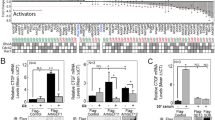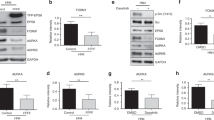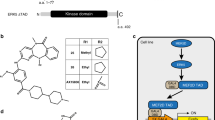Abstract
MANY growth factors regulate the cytoplasmic Raf-1 protein kinase1–10, consistent with its having a central role in transduction of growth signals. The kinase is ubiquitously expressed11 and can promote proliferation12, presumably in a manner dependent on growth-factor receptors and membrane-associated oncogenes13–15. We have now examined the dependence of serum- and TPA (12-O-tetradecanoylphorbol-13-acetate)-regulated NIH/3T3 cell growth on RAF-1 kinase to determine whether Raf-1 is essential for receptor signalling. We inhibited Raf-1 function by expressing c-raf-1 antisense RNA or kinase-defective c-raf-1 mutants. Antisense RNA for c-raf-1 interferes with proliferation of normal NIH/3T3 cells and reverts raf- transformed cells. In revertant cells, DNA replication induced by serum or TPA was eliminated or reduced proportionately to the reduction in Raf protein levels. Expression of a kinase-defective Raf-1 mutant (craf301) or a regulatory domain fragment (HCR) inhibited serum-induced NIH/3T3-cell proliferation and raf transformation even more efficiently. Inhibition by antisense RNA or craf301 blocked proliferation and transformation by Ki- and Ha-ras oncogenes. We conclude that raf functions as an essential signal transducer downstream of serum growth factor receptors, protein kinase C and ras.
This is a preview of subscription content, access via your institution
Access options
Subscribe to this journal
Receive 51 print issues and online access
$199.00 per year
only $3.90 per issue
Buy this article
- Purchase on SpringerLink
- Instant access to full article PDF
Prices may be subject to local taxes which are calculated during checkout
Similar content being viewed by others
References
Morrison, D. K. et al. Cell 58, 649–657 (1989).
App, H. et al. Molec. cell. Biol. (in the press).
Blackshear, P. J., Haupt, D. M., App, H. & Rapp, U. R. J. biol. Chem. 265, 12131–12134 (1990).
Kovacina, K. S. et al. J. biol. Chem. 265, 12115–12118 (1990).
Turner, B. C. et al. Proc. natn. Acad. Sci. U.S.A. (in the press).
Carroll, M. P., Clarke-Lewis, I., Rapp, U. R. & May, W. S. J. biol. Chem. 265, 19812–19817 (1990).
Baccarini, M., Sabatini, D. M., App, H., Rapp, U. R. & Stanley, E. R. EMBO J. 9, 3649–3657 (1990).
Morrison, D. K., Kaplan, D. R., Rapp, U. R. & Roberts, T. M. Proc. natn. Acad. Sci. U.S.A. 85, 8855–8859 (1988).
Rapp, U. R. et al. in Cold Spring Harbor Symposia on Quantitative Biology. Vol. LIII, 173–184 (Cold Spring Harbor Laboratory, New York, 1988).
Siegel, J. N., Klausner, R. D., Rapp, U. R. & Samelson, L. E. J. biol. Chem. 265, 18472–18480 (1990).
Storm, S. M., Cleveland, J. L. & Rapp, U. R. Oncogene 5, 345–351 (1990).
Smith, M. R., Heidecker, G., Rapp, U. R. & Kung, H. Molec. cell. Biol. 10, 3828–3833 (1990).
Rapp, U. R., Cleveland, J. L., Bonner, T. I. & Storm, S. M. in The Oncogene Handbook (eds E. P. Reddy, A. M. Skalka, and T. Curran) 213–253 (Elsevier Science. The Netherlands, 1988).
Smith, M. R., DeGudicibus, S. J. & Stacey, D. W. Nature 320, 540–543 (1986).
Noda, M., Selinger, Z., Scolnick, E. M. & Bassin, R. H. Proc. natn. Acad. Sci. U.S.A. 80, 5602–5606 (1983).
Heidecker, G. et al. Molec. cell. Biol. 10, 2503–2512 (1990).
Schultz, A. M., Copeland, Oroszlan, S. & Rapp, U. R. Oncogene 2, 187–193 (1988).
Rapp, U. R. et al. Proc. natn. Acad. Sci. U.S.A. 80, 4218–4222 (1983).
Mulcahy, L. S., Smith, M. R. & Stacey, D. W. Nature 313, 241–243 (1985).
Yu, C. L., Tsai, M. H. & Stacey, D. W. Cell 52, 63–71 (1988).
Cai, H., Szeberenyi, J. & Cooper, G. M. Molec. cell. Biol. 10, 5314–5323 (1990).
Szeberenyi, J., Cai, H. & Cooper, G. M. Molec. cell. Biol. 10, 5324–5332 (1990).
Huleihel, M. et al. Molec. cell. Biol. 6, 2655–2662 (1986).
Clanton, D. J., Lu, Y., Blair, D. G. & Shih, T. Y. Molec. cell. Biol. 7, 3092–3097 (1987).
Bonner et al. Nucleic Acids Res. 14, 1009–1015 (1986).
Kolch, W. et al. Oncogene 5, 713–720 (1990).
Author information
Authors and Affiliations
Rights and permissions
About this article
Cite this article
Kolch, W., Heidecker, G., Lloyd, P. et al. Raf-1 protein kinase is required for growth of induced NIH/3T3 cells. Nature 349, 426–428 (1991). https://doi.org/10.1038/349426a0
Received:
Accepted:
Issue Date:
DOI: https://doi.org/10.1038/349426a0



